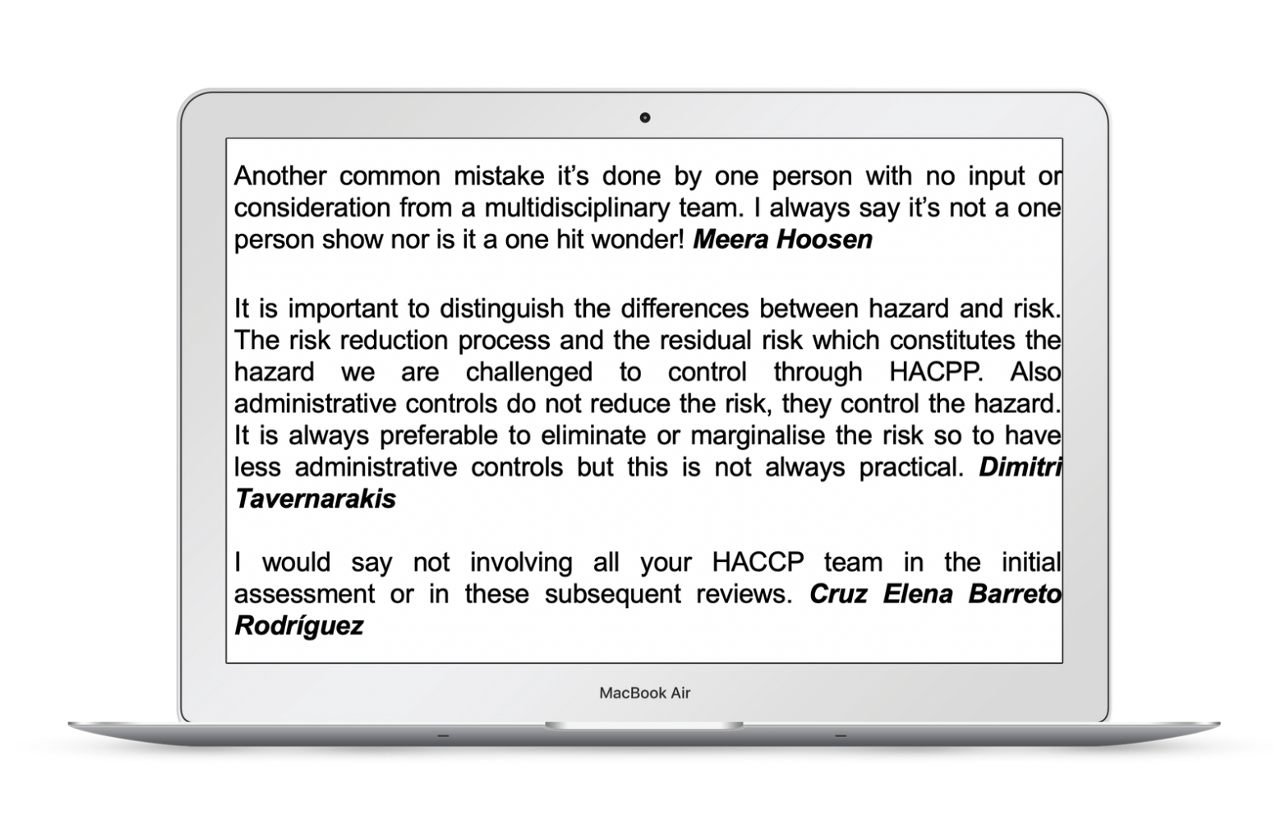
I want to make clear that doing a Hazard Assessment is not a piece of cake. This is due to the fact that we are evaluating the likelihood of hazards in food and severity of adverse effects on humans.
I want to make clear that doing a Hazard Assessment is not a piece of cake. This is due to the fact that we are evaluating the likelihood of hazards in food and severity of adverse effects on humans.
Conducting a Hazard Analysis is in the first principle (1st Principle of 7, Step 6 of 12) of HACCP implementation. According to the General Principles of Food Hygiene, from the Codex Alimentarius Commission, Hazard analysis is the process of collecting and evaluating information on hazards identified in raw materials and other ingredients, the environment, in the process or in the food, and conditions leading to their presence to decide whether or not these are significant hazards.
In this document, Codex Alimentarius presents 9 aspects that should be considered when conducting Hazard Analysis. Among those aspects, it can be found the likelihood of occurrence of hazards and the likelihood and severity of adverse health effects, also commonly known as Hazard Assessment.
The figure below presents the 3 main steps of HACCP principle number 1.

Hazard Assessment is one of the most important aspects to develop an effective HACCP.
To be conducted correctly, this assessment requires a thorough review of the scientific literature on the hazards commonly associated with a particular food product and a profound knowledge of the hazards associated with producing or processing the specific types of food.
For this reason, before starting to determine the likelihood of occurrence and severity of adverse health effects, the food safety team must build a robust base of resources and references documentation to support their decisions. This is why Codex has 9, and not 2, aspects to consider in Hazard Analysis, and ISO 22000 has a clause named Preliminary steps to enable Hazard Analysis.
Having insufficient documented support for the Hazard Assessment can be considered the initial mistake that precedes all the others presented below.
Before jumping into sharing the common errors I have seen out there, I want to make clear that doing a Hazard Assessment is not a piece of cake. This is due to the fact that we are evaluating the likelihood of hazards in food and severity of adverse effects on humans. According to the different food matrices, the likelihood of occurrence of hazards, and in the case of biological hazards, their ability to grow or multiply, can vary significantly. On the other side, the severity of the adverse effects can also be dependent on the particular human response (e.g., compromised immune system).
The most common mistakes at this initial step are:
1- The likelihood is minimized and not well justified. Don’t forget to factor in the organization’s history, industry statistics, public recalls, and public databases.
2- The severity is not supported on reliable references and resources (e.g., competent authorities or international expert groups).
3- The assessment is copied from an external source and not adapted to the organization.
4- Site Process Zone Layout, equipment, process, and environmental hazards are not assessed.
5- The assessment is not reviewed regularly.
6- Radionuclides 1,2,3 are not included as part of the chemical hazard assessment.
This is a topic that I have previously discussed with my SLO Food Safety community. I thought it would be a good idea to share with you some of their insights.

Don’t forget, having a control measure is never a justification for not considering a hazard. All potential hazards should be assessed. According to 2020’s version of the General Principles of Food Hygiene, from the Codex Alimentarius Commission, likelihood of occurrence should be determined by considering prerequisites as preventive controls but in the absence of additional controls. What this means is that, an efficient Pest Control Programme will reduce the likelihood of contamination through pests and should be taken in consideration when assessing this hazard. In contrast, if the business has a metal detector (control measure) this shouldn’t be considered when assessing the likelihood of metal contamination (reducing it).
One final note to the importance of the entire multi-disciplinary HACCP team working on the Hazard Assessment and when necessary, invite other personnel from different areas. For example, this is relevant when the need to change or substitute an ingredient and/or the origin of an ingredient arises. Having a multidisciplinary HACCP team is very important because even though most Hazards and HACCP knowledge may be on the food safety professional, it is crucial the contribution of other members for the all team to gain knowledge of aspects such as personnel, processes, and equipment.
https://www.fao.org/documents/card/es/c/b809f8d5-ceba-4c44-9ff5-c2f8ab601666/
This article was written by:

Nuno F. Soares
Contributing Editor: Jocelyn C. Lee, Food Safety Consultant
Disclaimer: The information contained on this article is based on research done in the last months and the authors personal experience and opinion. It is not intended to represent the view of any organization they work for or collaborate with. The authors will not be held liable for the use or misuse of the information provided in the article.